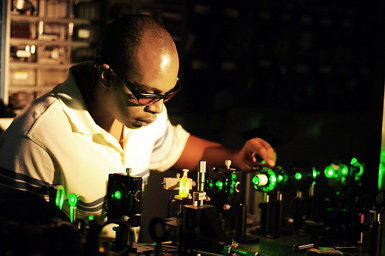Electronics, Photonics, and Digital Media Sectors: Key to Future U.S. Competitiveness
These interconnected industries will be drivers in stimulating economic growth, creating jobs, and improving global competitiveness. Collaboration among private-sector companies, universities, and government on research and commercialization will be vital.
Q3 2014

Photons (light) have several advantages over electrons for transporting energy and data. In electronics, traditional semiconductors are reaching their performance limits for capacity, speed, heat, and energy consumption. Thanks to new research breakthroughs, both photonics and electronics can be built into integrated systems that are only a few atoms thick. And, as new components become smaller, lighter weight, and more flexible, engineers have more options for design creativity.
Advances in these fields will continue to revolutionize the electronic products that are so embedded in our lives today, such as the Internet, smartphones, video games, television, barcode scanners, etc. Photonics, electronics, and digital media are all moving forward in a steady front, creating new products that improve quality of life around the globe. These industries are also key drivers in stimulating economic growth, creating jobs, and improving global competitiveness.
Photonics
Photonics is the science and application of light. Sectors that depend on photonics include advanced manufacturing, information and communications technology (ICT), defense and national security, energy, and health and medicine. The global photonics market produces about $500 billion in products every year — which are critical components for booming global ICT and telecommunication markets (estimated to be worth about $4.5 trillion combined).
Unfortunately, the U.S. has not kept pace in recent years with other countries (for example, Germany and China) regarding photonics research and development. To improve U.S. competitiveness, in 2012 the National Research Council proposed the National Photonics Initiative, which supports increased collaboration among private-sector companies, universities, and government on photonics research and commercialization.
Advancements in photonics are creating interest in shifting from electron-based devices to products that depend on photons (light). This change is expected to result in devices that are smaller, faster, and more energy-efficient. For example, lighting systems that rely on photonics can reduce electricity usage by up to 50 percent — which also reduces greenhouse gas emissions because fewer fossil fuels are consumed. Another example is the liquid-crystal display (LCD) that is so prevalent in electronic devices today. Standard LCD technology consumes a substantial amount of energy — up to 40 percent of total display power is consumed by backlighting alone. However, new photonic products — such as organic light-emitting diodes — have the potential to greatly reduce the energy consumption in LCDs.
Key photonics clusters in the U.S. are located in Arizona, California, Colorado, Michigan, North and South Carolina, and Florida. One of the country’s largest photonics research institutions is Stanford University’s Photonics Research Center. Here cross-disciplinary scientific teams work on lasers, optics, solar cells, neuroscience, microscopy, and other light-related projects. Discoveries include a recently announced eye implant for people suffering from macular degeneration and other retinal diseases. The implant consists of tiny photodiodes that are implanted under the retina and can transmit images using photons.
Another top research organization is the University of Central Florida’s College of Optics and Photonics (CREOL). Research areas include lasers, fiber optics, semiconductors and integrated photonics, optics imaging, and sensing and display. The college recently received about $1.3 million in federal grants for defense-related work on lasers, x-ray diffraction systems, and related technology. UCF researchers are working on photonics projects that have global implications, including a method for using high-energy lasers to trigger rain or lightning. Another team is using nano-transfer printing to create nanostructures that can be engineered to bend light around an object, so that it appears invisible. The scientists hope these nanostructures can be eventually manufactured in larger sheets and used to cover objects such as fighter jets, so they are invisible to detection systems.
Electronics and Photonics Merge
Photonics and electronics can be brought together at the scale of a computer chip. Global ICT companies are developing silicon photonic computer chips, which enable the download of large digital files, at much faster data-transmission speeds. For example, two to three seasons of a high-definition television show could be downloaded in a matter of seconds.
Photonic and electronic systems can both be constructed on the same silicon chip, creating a complex microcircuit that seamlessly transfers data from one system to the other. Silicon photonic chips can also be manufactured in high volume at reasonable cost using standard semiconductor fabrication methods.
Because silicon microphotonics can do more with less power, they are especially attractive to large energy users like date-center operations. With the increased bandwidth and Internet speeds, these chips will make it easier to process “big data” — a procedure that many companies are embracing to streamline operations, evaluate markets, and analyze customer preferences.
Top semiconductor sectors include Texas, California, New York, and Michigan. Austin — nicknamed “Silicon Hills” — continues to be a hotbed of semiconductor research and development. Semiconductor and software firms attract nearly half of the venture capital that is invested in Austin’s private sector. Major producers are Freescale Semiconductor, Spansion, and Samsung. Recently announced expansions by electronics and ICT firms in Austin include National Instruments ($80 million, 1,000 new jobs) and Oracle ($5.4 million, 200 jobs).
In New York, GLOBALFOUNDRIES continues to introduce advanced semiconductor platforms for advanced manufacturing industries. In May 2014 the company announced a 55-nanometer semiconductor-manufacturing platform designed specifically to meet the stringent and evolving needs of the automotive industry. This platform will be used to develop more sophisticated semiconductors to power safety, body, powertrain, and information/entertainment applications in vehicles.
“Better fuel efficiency, higher safety standards, increased in-vehicle communications capabilities, and more demanding consumer requirements are all driving the need for more performance and lower-power integrated circuits for these systems,” says Paul Colestock, director of segment marketing for GLOBALFOUNDRIES.
Other top research areas in electronics include microelectronics and nanotechnology, communications, networking, power and energy systems, and biomedical imaging and sensing. For example, Azoi recently launched a health-monitoring device called Wello that fits onto a smartphone and measures vital signs, including blood pressure, electrocardiography, heart rate, blood oxygen, temperature, and lung function.
“We have developed a technologically advanced, yet easy-to-use tool to monitor health and facilitate better lifestyle choices,” says Hamish Patel, CEO at Azoi. “Our device is a not-so-small engineering feat in microelectronics, nanosensors, imaging, data analytics, and design that will hopefully help the world become a healthier place.”
Digital Media
Photonics, electronics, and micro-scale and nano-scale manufacturing play huge roles in the advance of the digital media industry. Digital media includes gaming, film and television, heath technology, robotics, smart systems, and “wearables.”
One of the hottest digital-media sectors is wearables — personalized digital-media communication devices that are worn on the body (for example, fitness trackers, gaming controls, etc.).
“Wristbands, smart watches, medical devices, and smart glasses will drive the market of wearables,” writes Ozoda Muminova on www.theguardian.com’s digital media trends blog. “This includes Google Glass, which will of course steal attention in 2014, creating imaginative opportunities for marketers. Advertising will get even more targeted — location, content, context, and mood-based ads; sponsored content cards; pay-per-gaze payment models; and integration with print, outdoor, and television.”
“According to research firm NPD, wearable device shipments will hit 48 million units this year and explode to 91 million in 2015,” reports Don Reisinger at www.eweek.com. “The operating system is essentially a stripped-down version of Android that has been redesigned to take full advantage of the small displays found in a smart watch or other wearable computing devices.”
Digital media is also expanding the capabilities of medical devices and instruments. When combined with wireless technologies, these products can transmit and analyze data in real time — making them ideal for at-home care monitoring. Digital media is also being used to track the migration of disease and to mobilize emergency responses, which are critical for containing outbreaks, pandemics, or other health threats.
Amelia Burke-Garcia, director of the Center for Digital Strategy and Research for Westat, a research corporation in Rockville, Maryland, recently co-authored an article in the Journal of Public Health that examined how digital media is being used for public health research and communications. She indicates that more healthcare organizations are turning to digital media to communicate with larger segments of the population, especially for disease management information and news alerts.
Another rapidly growing segment of digital media is the Internet of Things (IoT), which refers to the explosion of smart devices or smart products that provide immediate access or control through the Internet. This demand for real-time connectivity is also leading to the development of new automation tools and sensor technologies that improve our “smartness” — smart homes, smart cars, biochips, monitoring devices, etc.
Muminova indicates that the IoT market, and all its supporting devices, will show significant growth in 2014: “Business Intelligence forecasts the number of IoT-enabled objects to go from just under 1.85 billion in 2013 to over 2.5 billion in 2014 and 9 billion in 2018, when they will account for half of all Internet-enabled devices,” he says. “Imagine smart objects surrounding us in smart homes, offices, and on the streets. Or everyday objects and appliances that can monitor their environment, report their status, receive instructions, and even take action based on the information they receive from our PCs, smartphones, and tablets. This will start an era in which we no longer search for things, but they search for us and location-based marketing becomes ubiquitous.”
Robert Hof, in a recent Forbes.com article that discusses key trends in consumer electronics, indicates that new developments in sensor technologies will lead to increased autonomy. “For example,” he says, “the use of sensors such as accelerometers and gyroscopes in all kinds of products will allow these products to work fairly independently in response to external stimuli. When we start to embed camera devices on the front of the car, we can do adaptive cruise control to stay in the lane. Some cars now have ‘park assist’ that beeps when there’s a parking space and then tell you to take your hands off the wheel so it can park automatically. So, we’re starting to digitize these everyday things. We can then make decisions more quickly, or let machines do tasks on our behalf.”
Project Announcements
Teradyne Plans Wixom, Michigan, Robotics Operations
12/11/2025
Natrion Plans Erie County, New York, Battery Components Operations
12/11/2025
Modus21 Expands North Charleston, South Carolina, Operations
12/10/2025
Norway-Based Cognite Plans Tempe, Arizona, Headquarters Operations
12/09/2025
France-Based Pasqal Plans Chicago, Illinois, Headquarters Operations
12/07/2025
LayerZero Power Systems Expands Streetsboro, Ohio, Manufacturing Operations
12/06/2025
Most Read
-
The Workforce Bottleneck in America’s Manufacturing Revival
Q4 2025
-
Rethinking Local Governments Through Consolidation and Choice
Q3 2025
-
Lead with Facts, Land the Deal
Q3 2025
-
How Canada Stays Competitive
Q3 2025
-
Investors Seek Shelter in Food-Focused Real Estate
Q3 2025
-
America’s Aerospace Reboot
Q3 2025
-
The Permit Puzzle and the Path to Groundbreaking
Q3 2025



